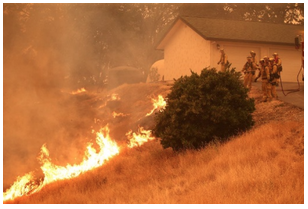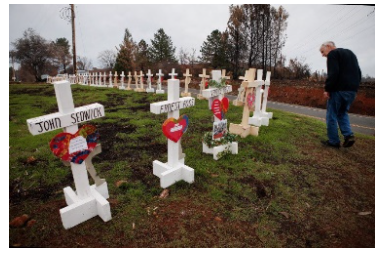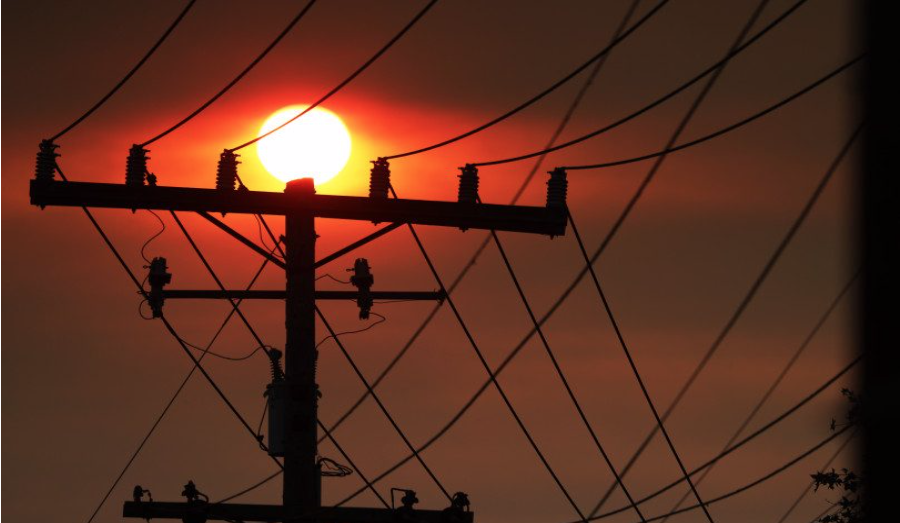CommentsCAL MATTERS--Pacific Gas & Electric’s bankruptcy has set off a financial race among creditors, bondholders, wildfire victims, insurers and others hoping to recover as much money as they can from California’s largest utility.
The road to rehabilitation is expected to be twisty and long, lasting two to three years. (Photo above: PG&E’s bankruptcy woes could compound the pain for Californians if the massive utility ends up causing the next big wildfire. Photo by Ray Chavez/Bay Area News Group.)
But for Californians confronting the new normal of climate-driven wildfire, PG&E’s woes have an additional wrinkle: the likelihood that the state’s pain will be compounded if PG&E ends up causing the next big disaster—which, given PG&E’s size and record, is a real possibility.
Like all California utilities, PG&E has filed extensive wildfire prevention plans. In addition to removing trees, adding weather stations and insulating equipment, the utility serving northern and central California has vowed to expand power shut-off territory to as many as 5.4 million customers, up from 570,000 today.
However, PG&E is a prime suspect in the deadliest fire in state history, the Butte County Camp Fire. And a recent Los Angeles Times report citing the California Public Utilities Commission found that of more than 2,000 wildfires between June 2014 and December 2017 traced to utilities, more than 1,500 were caused by PG&E equipment.
Should PG&E be liable for another major wildfire while the company is still reorganizing in bankruptcy court, it would add costs for consumers and complicate claims for victims. PG&E’s 16 million customers, who are already expected to shoulder bankruptcy debts, would have to pay off new wildfire costs and any new safety measures ordered by a federal judge.
In a twist, victims of the next PG&E fire would jump ahead of existing PG&E victims–and likely collect more–as a result of how claims get prioritized in bankruptcy proceedings.
“If I were an existing tort victim, I’d say it’s terrible,” said Robert Rasmussen, a law professor specializing in bankruptcy at the Gould School of Law at the University of Southern California.
Growing risk and high stakes
 The PG&E story is playing out against the broader realization that climate change is about to become breathtakingly costly. Already, insurers are adjusting premiums to reflect the rising frequency and severity of disaster in the state.
The PG&E story is playing out against the broader realization that climate change is about to become breathtakingly costly. Already, insurers are adjusting premiums to reflect the rising frequency and severity of disaster in the state.
Wildfire damages from the past two years alone have been so staggering that insurance companies say it could take until the middle of the century for them to break even. Meanwhile, as insurance rates climb in wildfire country, insurers say homeowners, may be scrimping or buying no coverage.
Rex Frazier, president of the Personal Insurance Federation of California, said studies show that as insurance rates rise, consumers are more likely to consciously under-insure, often not even covering their cost of rebuilding.
“It’s an affordability issue,” Frazier said. “People just buy less.”
Meanwhile, the environmental risk grows. State and federal forestry officials announced this week that 147 million trees have died in California since 2010. The trees are the direct victims of drought and disease and become fuel for the next wildfire season.
At ground zero of that ongoing risk are California’s utilities, who fight increasingly long odds as they struggle to keep equipment from sparking towering infernos while keeping the lights on. For them, too, the market has spoken. Credit rating agencies have downgraded not just PG&E but also Southern California Edison and the parent company of San Diego Gas & Electric amid concerns about exposure to fire claims.
The situation has offered state lawmakers few easy political solutions.
“This pressure comes at a time when the entire energy market is evolving,” Gov. Gavin Newsom noted in his State of the State address. “From roof-top solar and wind generation to smart grid technologies, from community choice aggregators to direct access service, otherwise known as power purchasing agreements, more and more of our electricity now is procured outside of investor-owned utilities.
“Regulations and insurance practices created decades ago didn’t anticipate these changes. So, we must map out longer-term strategies, not just for the utilities’ future, but for California’s energy future, to ensure that the cost of climate change doesn’t fall on those least able to afford it.”
Newsom has assembled a strike team of climate experts and bankruptcy lawyers to deal with the PG&E fallout, and said they’ll be working for the next two months on a comprehensive strategy.
Victims vs. victims
 A Paradise resident looks for the name of his neighbor among the 86 crosses erected for Camp Fire victims. Photo by Karl Mondon/Bay Area News Group.
A Paradise resident looks for the name of his neighbor among the 86 crosses erected for Camp Fire victims. Photo by Karl Mondon/Bay Area News Group.
Even before the bankruptcy, legal experts and lawmakers warned that those who lost loved ones and homes in the recent wildfires might end up being shortchanged.
Lawyers representing 2017 and 2018 fire victims understood that a Chapter 11 filing disadvantaged their clients as unsecured creditors in bankruptcy proceedings. When a company files for bankruptcy, civil lawsuits get put on hold. This automatic “stay,” impairs the negotiating leverage of plaintiffs, who often end up settling for a fraction of what they might have gotten otherwise.
Knowing this, fire victims held a last-ditch rally at the Capitol with legal activist Erin Brockovich to demand the state keep PG&E out of bankruptcy. But that was just one example of the complexity posed by bankruptcy law.
In another legal surprise, any new wildfire victims could jump ahead of old victims because new claims would have to be filed in bankruptcy court, as opposed to state court. Bankruptcy follows different proceedings, which would deem them administrative claims.
Rasmussen said that creates tension between new and old victims. And, he added, bankruptcy proceedings could allow the new victims to be more speedily paid.
Why a PG&E bankruptcy?
Under state law, utilities face strict liability for damages from any fire traced to its equipment, even if they were not negligent. This is known as inverse condemnation. Though the legal doctrine has been around for decades, it has become problematic for utilities as the state experiences longer bouts of drought and hot weather. Seven of the 10 most destructive wildfires in state history have happened in the last five years.
At the same time, state regulators have seemingly made it harder to pass liability costs to customers. In 2017, the five-member California Public Utilities Commission, the state agency that oversees investor-owned utilities, blocked San Diego Gas & Electric from passing on $379 million in liability costs on the premise that the utility’s management of its facilities is unreasonable.
Though PG&E was exonerated in the 2017 Tubbs Fire in California’s wine country, Cal Fire has linked the company to 17 other major wildfires that year. Investigators have not yet determined whether PG&E equipment sparked the massive Camp Fire, as suspected, but that November catastrophe left 85 people dead.
PG&E has estimated its potential liability as high as $30 billion. With the utility still on federal probation for six felonies related to the San Bruno gas line explosion, it opted not to ask state regulators for permission to pass on costs to its customers.
Instead, it filed bankruptcy, saying it was the only viable option.
“Why does PG&E love bankruptcy so much? Because customers don’t have a voice,” said Mindy Spatt, a spokeswoman for The Utility Reform Network, a consumer rights organization. She noted that when PG&E filed bankruptcy in 2001, customers were left paying back $8 billion.
In the current bankruptcy, the San Francisco-based company argued that it was facing a cash flow problem and needed access to financing in order to make its grid safer. When it filed bankruptcy, it listed $51.7 billion in debts and $71.4 billion in assets.
“We intend to work together with our customers, employees and other stakeholders to create a more sustainable foundation for the delivery of safe, reliable and affordable service in the years ahead,” said PG&E interim CEO John Simon in a statement. “This is our goal.”
Safety costs, human liability
If U.S. Bankruptcy Judge Dennis Montali, who is assigned to oversee the restructuring, approves a trust to be set up for the wildfire victims, it would let PG&E cap its liabilities up to the point of the January bankruptcy filing. It would be in the company’s favor to lowball the estimated claims.
Rasmussen, the law professor, said that’s what happened in the 1980s when claims were grossly underestimated in an asbestos case related to the Johns-Manville company.
“Originally there was some thought they’d be paid close to 100 cents on the dollar,” Rasmussen said. “As it turns out, asbestos has a long latency. You could have been injured decades ago, and you go to the trust fund, you get paid something like five cents on the dollar.”
Bankruptcy, however, may not get PG&E off the hook for much-needed safety improvements.
U.S. District Judge William Alsup, who has declared PG&E in violation of its probation in the 2010 San Bruno gas pipeline explosion, could order the company to spend $75 billion to $150 billion to thoroughly inspect its electricity grid and extensive vegetation management ahead of the fire season. A PG&E attorney told the judge such an order could take eight years because there aren’t enough trained tree trimmers.
The state is also requiring major utilities to submit annual fire prevention plans, which include trimming trees, replacing wood poles with metal poles, shutting off power during red flag weather warnings and more.
Rasmussen said any decision Judge Alsup makes will be deemed an administrative claim along with potential new wildfire victims. Administrative claims fall behind creditors with collateral but before unsecured claims such as bondholders and tort claims, including existing wildfire victims.
“Going forward, PG&E is going to have to pay everyone it deals with,” the law professor said.
‘What was accomplished?’
The state has yet to be tested on whether a new wildfire cost recovery plan will be enough to assure Wall Street lenders that California’s utilities have a viable process for withstanding disasters. Otherwise the state’s major investor-owned utilities will continue to experience credit downgrades that raise the price of all Californians’ electricity.
The Legislature made it easier last year for utility companies to absorb the cost of fire damages by borrowing from the state and charging customers to pay back the bonds over many years, a procedure called securitization.
Democratic Sen. Bill Dodd, whose district includes fire-ravaged Napa, said lawmakers voted for the plan, SB 901, not because they wanted to bail out PG&E, but to protect wildfire victims and customers.
“We were trying to make sure victims don’t get victimized again,” he said. “It was how do we make sure ratepayers don’t get hammered in this whole process. The only way to do that was to keep PG&E out of junk-bond status and keep PG&E out of bankruptcy. And the reality of the cost of doing that was far less than the cost to ratepayers and victims if they did file bankruptcy.”
Now, of course, that bankruptcy has occurred anyway—a move that Dodd calls “the ultimate PG&E bailout”—and state policymakers aren’t sure how much it will complicate the state’s new wildfire rules for utilities.
If there’s another mega-wildfire with PG&E at fault, those homeowners with insurance would be paid by their insurance companies. The utility, too, would be able to use its own insurance to offset some of the costs. PG&E would then ask state regulators at the California Public Utilities Commission for permission to pass on the remaining fraction that they need help paying.
Under SB 901, the state can consider the financial health of the company; a five-member Commission on Catastrophic Wildfire Cost and Recovery would help regulators decide whether utilities can pass costs onto consumers.
The problem, though, is that SB 901 wasn’t enough to keep PG&E from filing bankruptcy. Behind the scenes, suggestions for financial fixes or creating a disaster insurance similar to the state’s earthquake insurance program are being tossed around. But even if California’s utilities truly need help reducing liability, no one in Sacramento wants to be viewed as bailing out PG&E.
Spatt of the consumer advocacy group TURN said political repairs won’t do unless the company truly prioritizes safety. Half of PG&E’s board of directors is unlikely to return after its May shareholder meeting.
“What was accomplished?” she said of last year’s legislative debate. “The company still went bankrupt. No difference was made in safety operations. What a disaster.”
(Judy Lin covers the environment for CalMatters … where this perspective was first posted.)
-cw
















